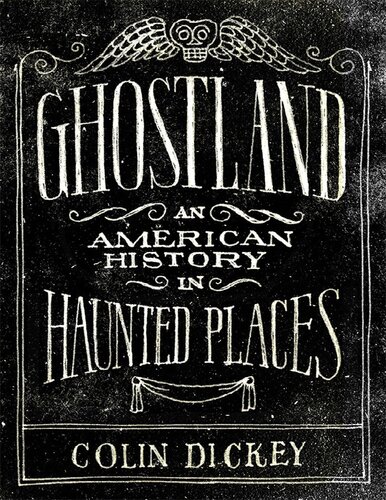
Ghostland
An American History in Haunted Places
کتاب های مرتبط
- اطلاعات
- نقد و بررسی
- دیدگاه کاربران
نقد و بررسی

July 4, 2016
In the introduction to this illuminating study of so-called true hauntings and the American public’s enduring fascination with them, Dickey (Cranioklepty) posits that “ghost stories reveal the contours of our anxieties, the nature of our collective fears and desires, the things we can’t talk about in any other way.” Grouping haunts into four categories—houses, hangouts, institutions, and entire towns—he shows how the persistence of these ghost stories, especially when their details change with the times, say more about the living than the dead. Noting how popular accounts of the ghost of Myrtles Plantation has shifted over the years from that of an abused slave to revenants from a Native American burial ground beneath the plantation, Dickey notes that “ghost stories like this are a way for us to revel in the open wounds of the past.” Describing the ghost stories that cropped up in New Orleans in the wake of Hurricane Katrina’s devastation, he writes that ghost stories “are how cities make sense of themselves: how they narrate the tragedies of their past, weave cautionary tales for the future.” In contrast to many compendia of “true” ghost stories, Dickey embeds all of the fanciful tales he recounts in a context that speaks “to some larger facet of American consciousness.” His book is a fascinating, measured assessment of phenomena more often exploited for sensationalism. Agent: Anna Sproul-Latimer, Ross Yoon Agency.

"If you want to understand a place, ignore the boasting monuments and landmarks, and go straight to the haunted houses."So begins Dickey's (Creative Writing/National Univ.; Afterlives of the Saints: Stories from the Ends of Faith, 2012 etc.) exploration into the ghost stories of America and what they reveal about society. On his quest, the author examines every manner of haunted place, from houses like the Seven Gables in Salem, Massachusetts, which inspired Nathaniel Hawthorne's Gothic romance of the same name, to haunted cities like New Orleans as well as asylums, cemeteries, battlefields, and haunted hotels. While not a new concept, Dickey's theme has been more extensively explored where fairy tales and general folklore are concerned. In each location, the author reveals not only the ghost stories of the site, but also, most importantly, the site's true history. This allows us to see how ghost stories often say "more about the tellers than they do about the supernatural." Throughout history, ghost stories have been used to make money, offer a moral, mark a location, and explain the unexplainable, among many other functions. Interwoven throughout the narrative are the voices of writers and thinkers including Nabokov, Freud, Poe, Dickens, and Stephen King. Most revealing is the author's examination of the logical factors that contribute to hauntings--e.g., hotels feel eerie because they are uncannily not home, and homes often feel haunted because they have been abandoned. While the histories of the locations are well-expressed, Dickey's personal experiences can feel flat. The investigation feels especially poignant when he connects the nature of ghost stories to issues like race. Places like Shockoe Bottom in Richmond, where hundreds of black men, women, and children were tortured and buried, should surely offer up their share of ghosts, but most of the spirits have been white. "What does it mean to whitewash the spirits of a city?" Dickey asks. "Does Virginia have ghosts that it is not yet ready to face?" An intriguing but somewhat uneven exploration of things unseen. COPYRIGHT(1) Kirkus Reviews, ALL RIGHTS RESERVED.

September 1, 2016
Dickey, author of Cranioklepty (grave robbers stealing the skulls of the brilliant) and Afterlives of the Saints (the long-lasting influence of holy weirdness), continues his exploration of the strange and macabre with this latest work. Each chapter is an essay revolving around a spooky site or sighting. The focus ranges from specific landmarks such as the Winchester Mystery House in San Jose, CA, to institutions such as Southern U.S. plantations or asylums to entire cities such as Salem, MA, and New Orleans--all supposed magnets for supernatural activity. While the author doesn't question the veracity of the apparitions, the narratives are not your typical "gee whiz" ghost stories. Dickey pops sensationalist bubbles by observing the underlying racism, sexism, and classism associated with many hauntings' long-told tales. By exposing historical inaccuracies and sociological calumny, the work treats readers to a better understanding of the socioeconomic and political milieu in which these myths gained acceptance, ultimately providing a richer, more nuanced narrative. VERDICT Sophisticated readers with gothic sensibilities who enjoy literary histories, social commentary, and authoritative travelogs will find this a worthy title.--Janet Tapper, Univ. of Western States Lib., Portland, OR
Copyright 2016 Library Journal, LLC Used with permission.

























دیدگاه کاربران